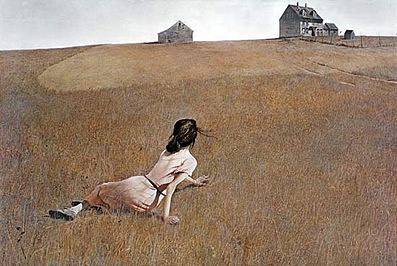| Andrew Wyeth | |
|---|---|
 |
|
| Born | July 12, 1917 Chadds Ford, Pennsylvania |
| Died | Jan. 16, 2009 (at age 91) Chadds Ford, Pennsylvania |
| Nationality | American |
| Movement | Realist |
| Field | Painter |
| Works | |
When the brilliant art historian Robert Rosenblum was asked to nominate the one person who best could be considered the “most underrated and overrated artist” of the 20th Century, he immediately named Andrew Wyeth.
Andrew Wyeth is a rare example of an artist who probably was not only born and destined to be an artist, but he fulfilled that potential magnificently over a long life of 91 years. He left behind an enormous body of work. His paintings enabled him to amass a fortune, and he also won the praise and adulation of elites in the intellectual community–but not everyone was a fan of his work.
Early Life
Artistic talent was undoubtedly in Wyeth’s genes because his father, N.C. Wyeth, is considered to be one of America’s greatest illustrators. The elder Wyeth created more than 3,000 paintings and illustrated an astounding 122 books. N.C. Wyeth was an ardent admirer of the great American naturalist and writer Henry Thoreau, and so when Andrew Wyeth was born on July 12, 1917 – the same day as Thoreau’s birth — the father couldn’t help but think this was some kind of cosmic synergy.
 N.C. Wyeth lavished much personal attention on all of his children. He home-schooled his son Andrew, along with his other children. Because he was home schooled, Andrew Wyeth developed a powerful sense of focus and a personal vision for art. He was free from the many distractions that can result of attending school or art school with hundreds of other young people. The fact that Andrew Wyeth received intense personal schooling of art technique from a father–who just happened to be a great talent in his own right–set the stage for the career of a unique artistic power.
N.C. Wyeth lavished much personal attention on all of his children. He home-schooled his son Andrew, along with his other children. Because he was home schooled, Andrew Wyeth developed a powerful sense of focus and a personal vision for art. He was free from the many distractions that can result of attending school or art school with hundreds of other young people. The fact that Andrew Wyeth received intense personal schooling of art technique from a father–who just happened to be a great talent in his own right–set the stage for the career of a unique artistic power.
Wyeth was born in Chadds Ford, Pennsylvania, but the family also kept a summer home in Cushing, Maine. The natural landscape of these areas was to become a tremendous inspiration on the art of Andrew Wyeth, who lived his entire 91 years in this part of the world. For this reason his style is often described as “regionalist,” because he painted local people and his local surroundings.
Wyeth’s Style
Wyeth’s style is also described as “realism,” meaning that his works depicted what the eye sees – as opposed to abstract styles of painting which often do not depict images that look like anything we see in everyday life. Like his father, Wyeth was an “illustrator” of sorts.
By far, Andrew Wyeth’s most famous and enduring work is Christina’s World created in 1948. The painting depicts a woman who appears to be lying down, but also seems to be just getting up, lifting herself with her hands. Her head and torso is raised as she looks toward a farm house in the distance. She is on a vast field of tawny-brown prairie grass, and we see her from behind. In reality, this painting is of an actual person Wyeth knew. The woman, Christina Olson, was unable to walk because of partial paralysis brought on by polio, and so she frequently crawled around her property in Maine. Wyeth saw Christina crawling along one day and was inspired to paint her. Today Christina’s World is on display in the Museum of Modern Art in New York.
Public Exposure
 Wyeth’s first public exposure as an artist occurred about 10 years before he painted Christina. In 1937 when he was 20 years old the Macbeth Gallery in New York hosted an exhibit of his watercolors. His success was incredible and immediate. Every one of his watercolors were purchased by avid art collectors. It was clear that this young artist could connect with an audience, and an audience that had the cash to buy his works. Wyeth would never become the proverbial “starving artist.”
Wyeth’s first public exposure as an artist occurred about 10 years before he painted Christina. In 1937 when he was 20 years old the Macbeth Gallery in New York hosted an exhibit of his watercolors. His success was incredible and immediate. Every one of his watercolors were purchased by avid art collectors. It was clear that this young artist could connect with an audience, and an audience that had the cash to buy his works. Wyeth would never become the proverbial “starving artist.”
One of the advantages of Wyeth’s work is its straightforward visual appeal, which means it can more easily attract wide appreciation. Unlike abstract art, which can challenge or alienate a certain segment of the public, Wyeth’s works never embarrasses his viewers, especially people who may not possess a deeper understanding of art. In short, his paintings looked like “real pictures” or illustrations that do not ask the art viewer to make individual interpretation of the work.
The Helga Paintings
Another stunning series of works Wyeth is famous for are the Helga paintings. Incredibly, these are 247 distinct paintings of the same woman, who was Helga Testorf, a German immigrant Wyeth met at the farm of Karl Kreuner in Pennsylvania. There was a hint of scandal surrounding these paintings because Wyeth painted her through the years of 1971 and 1985, meeting his subject without the knowledge of his wife, or Helga’s husband John Testorf. Many of the paintings are nude.
Even more amazing is that all 247 of the Helga paintings were unknown until the day when Wyeth decided to release them to the public. The New York Times said this event “rocked the art world,” and not just because of the amazing quality of the paintings. Few could believe that this had been just an innocent artist-model relationship, but must have included a sexual affair. However, most believe today that Wyeth and Helga were not lovers, but that this was simply an incredible 14-year collaboration between a brilliant painter and extremely patient model whose looks fascinated him.
A wealthy Japanese businessman purchased the entire Helga series of paintings for a reported $40 to $50 million in the late 1980s, and they are almost certainly worth many times that amount today. Some estimate the man who purchased the Helga series realized a profit of 600%!
Wyeth and Art Critics
While Wyeth came to be adored by millions and also became a millionaire many times over, not all art critics are sold on his work. Some critics describe his work as “just basic illustrating,” while others say his “subject matter is tired” and “never innovative.” Comments like these are not unexpected in the world of modern art, where daring abstract paintings and other cutting-edge styles tend to be the darlings of critics.
But as we all know, “art is in the eye of the beholder.” Most critics probably agree that while Wyeth’s works hearkens back to an earlier century, and shared a style in common with the likes of Winslow Homer, there is more depth to his work than “basic illustration.” Wyeth’s art was not only “real” – but it also contained greater elements of form, content and meaning.